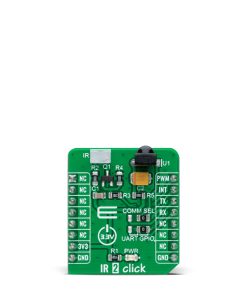Subtotal: R1,050.00
IR 2 Click
R150.00 ex. VAT
IR 2 Click is a compact add-on board representing a compact and easy solution for adding infrared (IR) remote control to your design. This board features the TSOP98638, a miniaturized sensor for receiving the modulated signal of QEE113 IR emitting diode from Vishay Semiconductors. This IR sensor module consists of a photodetector, pre-amplifier, and automatic gain control to surpass ambient noise with signals transmitted to it in the near-infrared range with a wavelength of 940nm. It also communicates with the target MCU via selectable GPIO lines. This Click board™ is suitable for IR repeater applications that improve your system and allow you more flexibility, sensitivity, and longer receiving range.
IR 2 Click is supported by a mikroSDK compliant library, which includes functions that simplify software development. This Click board™ comes as a fully tested product, ready to be used on a system equipped with the mikroBUS™ socket.
Stock: Lead-time applicable.
| 5+ | R142.50 |
| 10+ | R135.00 |
| 15+ | R127.50 |
| 20+ | R122.70 |

 tRF Click
tRF Click 
























